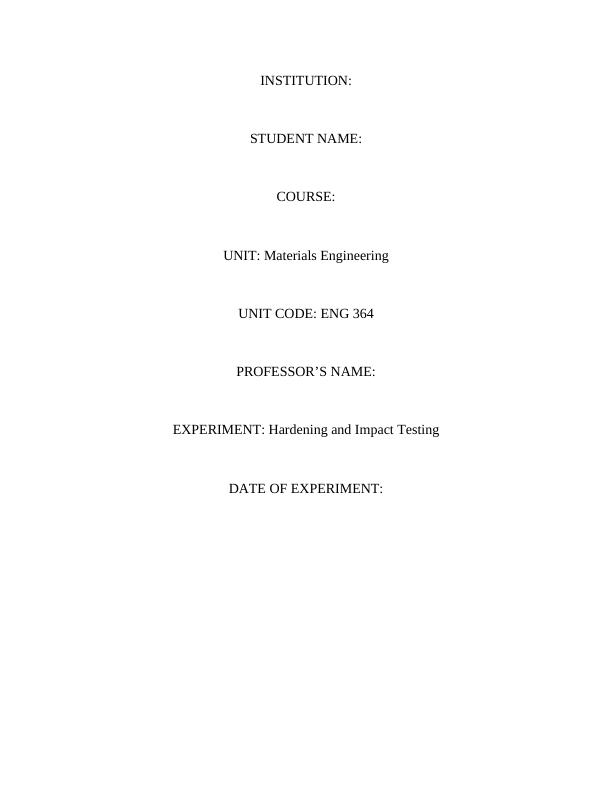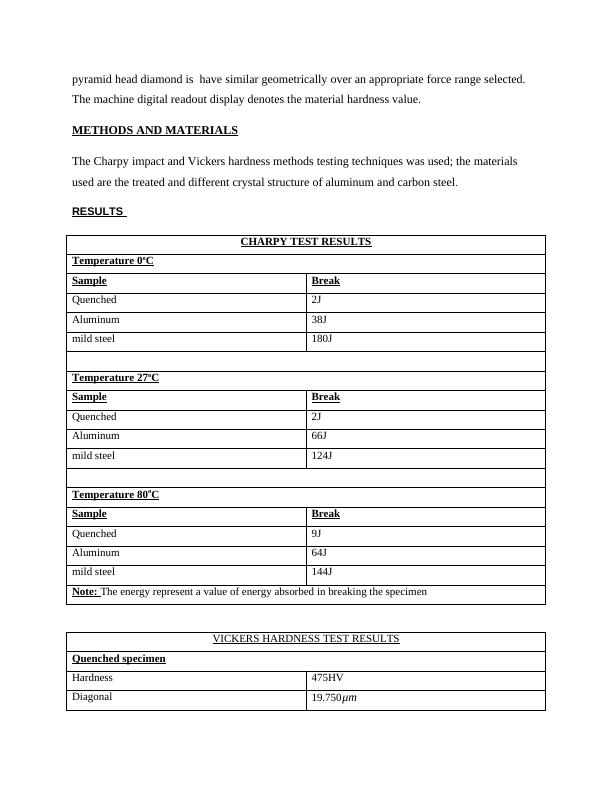Hardening and Impact Testing
Added on 2023-01-23
7 Pages1451 Words98 Views
INSTITUTION:
STUDENT NAME:
COURSE:
UNIT: Materials Engineering
UNIT CODE: ENG 364
PROFESSOR’S NAME:
EXPERIMENT: Hardening and Impact Testing
DATE OF EXPERIMENT:
STUDENT NAME:
COURSE:
UNIT: Materials Engineering
UNIT CODE: ENG 364
PROFESSOR’S NAME:
EXPERIMENT: Hardening and Impact Testing
DATE OF EXPERIMENT:

AIM
The main aim of this experiment is to use metals steel (BCC) and aluminum (FCC) to determine
effect of different hardening treatments and the crystal structure on material properties and
toughness by considering the Vickers hardness and the impact energy values.
INTRODUCTION
The carbon steel both high and medium is heat treated to form Austenite and then quenched in
either water or oil to form martensite. The formed martensite is very brittle and it is tempered so
as to increase its toughness.
Aluminum is treated through solution treatment so as to harden it at about 540C for an hour and
then quenched. The heat treated and quenched aluminum is then taken through age hardening at
175C for nearly 8 hours to further harden it.
The test hardness tests are the impact hardness test and the Vickers hardness test. The impact
testing for both the charpy and izod involve the use of a machine that as a pendulum moving at a
velocity of 3 to 4 m/s and the test piece sample to be used is a square of 10mm*10mm. The
machine has a notch angle of 45 degrees, 2mm deep and a root radius of 0.25mm. The energy
observe on the machine scale display during the impact denotes the toughness of the specimen
material.
The Vickers hardness testing involve the calculation of the Vickers hardness number HV given
by the equation;
H=1.854 P
d2
Where P=load ( Kg ) .
d=arithmetical mean of two diagonals of theidentation ( mm ) .
Diamond pyramid hardness test used is advantages over the Brinel hardness in since the hardness
number is independent of the size of the load used since all the impressions made by the
The main aim of this experiment is to use metals steel (BCC) and aluminum (FCC) to determine
effect of different hardening treatments and the crystal structure on material properties and
toughness by considering the Vickers hardness and the impact energy values.
INTRODUCTION
The carbon steel both high and medium is heat treated to form Austenite and then quenched in
either water or oil to form martensite. The formed martensite is very brittle and it is tempered so
as to increase its toughness.
Aluminum is treated through solution treatment so as to harden it at about 540C for an hour and
then quenched. The heat treated and quenched aluminum is then taken through age hardening at
175C for nearly 8 hours to further harden it.
The test hardness tests are the impact hardness test and the Vickers hardness test. The impact
testing for both the charpy and izod involve the use of a machine that as a pendulum moving at a
velocity of 3 to 4 m/s and the test piece sample to be used is a square of 10mm*10mm. The
machine has a notch angle of 45 degrees, 2mm deep and a root radius of 0.25mm. The energy
observe on the machine scale display during the impact denotes the toughness of the specimen
material.
The Vickers hardness testing involve the calculation of the Vickers hardness number HV given
by the equation;
H=1.854 P
d2
Where P=load ( Kg ) .
d=arithmetical mean of two diagonals of theidentation ( mm ) .
Diamond pyramid hardness test used is advantages over the Brinel hardness in since the hardness
number is independent of the size of the load used since all the impressions made by the

pyramid head diamond is have similar geometrically over an appropriate force range selected.
The machine digital readout display denotes the material hardness value.
METHODS AND MATERIALS
The Charpy impact and Vickers hardness methods testing techniques was used; the materials
used are the treated and different crystal structure of aluminum and carbon steel.
RESULTS
CHARPY TEST RESULTS
Temperature 0oC
Sample Break
Quenched 2J
Aluminum 38J
mild steel 180J
Temperature 27oC
Sample Break
Quenched 2J
Aluminum 66J
mild steel 124J
Temperature 80oC
Sample Break
Quenched 9J
Aluminum 64J
mild steel 144J
Note: The energy represent a value of energy absorbed in breaking the specimen
VICKERS HARDNESS TEST RESULTS
Quenched specimen
Hardness 475HV
Diagonal 19.750μm
The machine digital readout display denotes the material hardness value.
METHODS AND MATERIALS
The Charpy impact and Vickers hardness methods testing techniques was used; the materials
used are the treated and different crystal structure of aluminum and carbon steel.
RESULTS
CHARPY TEST RESULTS
Temperature 0oC
Sample Break
Quenched 2J
Aluminum 38J
mild steel 180J
Temperature 27oC
Sample Break
Quenched 2J
Aluminum 66J
mild steel 124J
Temperature 80oC
Sample Break
Quenched 9J
Aluminum 64J
mild steel 144J
Note: The energy represent a value of energy absorbed in breaking the specimen
VICKERS HARDNESS TEST RESULTS
Quenched specimen
Hardness 475HV
Diagonal 19.750μm

End of preview
Want to access all the pages? Upload your documents or become a member.
